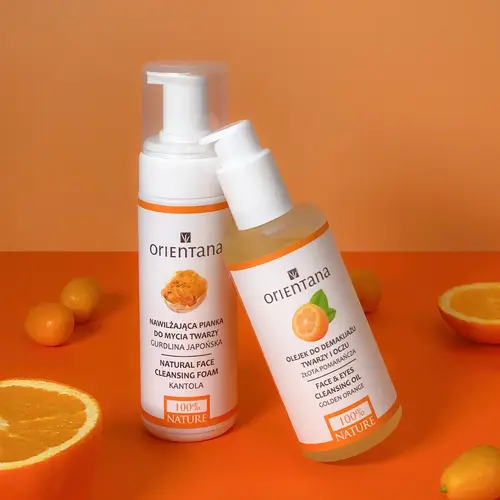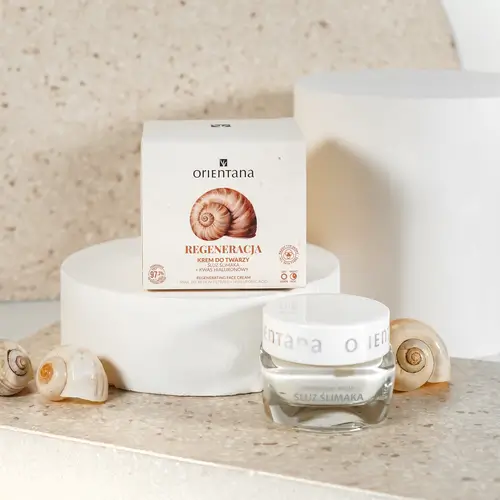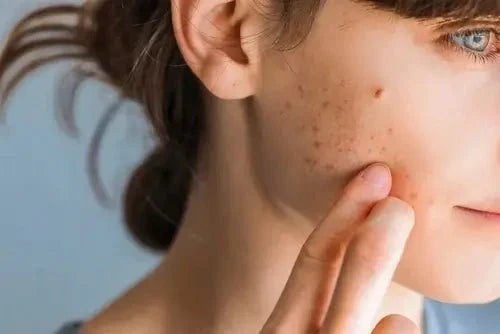Acne scars are a common dermatological problem that can significantly affect self-esteem and quality of life. One natural ingredient that can help reduce these scars is snail slime. In this article, we will discuss how snail slime can help treat acne scars and other methods to reduce them.
Acne Scars - Causes and Types
Acne scars are the result of inflammation that leads to damage to skin tissue. They form during the healing process of the skin when the body produces excess or deficiency of collagen. Acne scars are permanent and can significantly affect the appearance of the skin, causing aesthetic discomfort. There are different types of scars, including concave, convex, and linear.
Types of Acne Scars
Acne scars are permanent changes in the skin structure, resulting from impaired healing of acne-related inflammation. Their appearance and depth depend on many factors, such as the severity of acne, genetic predisposition, care method, and mechanical interference, such as squeezing or scratching the lesions. In cosmetology, there are several types of acne scars, each of which requires an individual therapeutic approach.
The most common are concave, or atrophic, scars, which are formed as a result of the loss of collagen and elastic skin fibers at the site of healing inflammation. There are three main types in this group: "ice pick" scars - narrow, deep and resembling pinpricks, "boxcar" scars - wider, with clearly marked edges and a rectangular shape, and "rolling" scars - with a wavy surface, which cause unevenness of the skin and are the result of tissue adhesions in the deeper layers of the skin.
The second type are raised scars, or hypertrophic scars, and keloids. They are caused by excessive collagen synthesis during the healing process, which leads to the scar being raised above the skin surface. Hypertrophic scars are usually limited to the site of the original injury, while keloids can grow beyond its boundaries. These types of changes are more often observed in people who are prone to scarring, especially in the chest, back, and jaw area.
The last category is linear scars, which are caused by mechanical damage to the skin, most often by scratching or improper removal of acne lesions. These types of scars take the form of thin, longitudinal lines and can be shallow or deeper, depending on the intensity of the injury.
Accurate assessment of the type of acne scars is crucial in selecting appropriate cosmetic and dermatological treatments, such as microneedling, chemical peels, laser therapy or hyaluronic acid treatments. Each type of acne scar requires an individual therapeutic approach, taking into account the skin structure and the degree of advancement of changes.
Acne Scars - Can They Be Prevented?
Preventing acne scars is possible, but requires a conscious and consistent approach to skin care and a quick response to emerging inflammatory changes. The key is to treat acne appropriately at an early stage - the sooner the inflammatory process is stopped, the lower the risk of damaging the deeper layers of the skin, and therefore acne scars may not occur.
One of the most common mistakes that contribute to scarring is mechanical removal of lesions – squeezing, scratching or pressing on immature pimples. Such actions can lead to damage to the skin structure, secondary bacterial infections and more intense inflammation, which significantly increases the risk of scarring, especially in the forehead, back or jaw area.
Additionally, a key preventative factor is thorough facial cleansing. If you use SPF or wear makeup, a double cleanse is essential.

Two-step facial cleansing is a method that originates from Asian care rituals and has also gained recognition in European cosmetology. Its effectiveness is based on the precise removal of impurities soluble in both fats and water, without disturbing the natural hydrolipid barrier of the skin.
The first stage of cleansing is based on the use of an oil-based product – this can be Golden Orange oil. Lipid substances effectively dissolve sebum, makeup, sunscreens and environmental pollutants that accumulate on the skin's surface during the day. The cosmetic is spread with dry hands on dry facial skin, gently massaging, and then rinsed off with warm water or removed with a damp cloth.
The second step involves using a water-based product – most often a gel or foam. This step removes any oily product residue and water-soluble impurities, such as sweat, dust and smog particles. A well-chosen water-based product should cleanse effectively but gently, without causing dryness or a feeling of tightness.
In scar prevention, daily, well-chosen care of acne skin is extremely important. Cosmetics should have anti-inflammatory, regulating and regenerative effects, while not irritating or drying the skin. Ingredients such as niacinamide, zinc, azelaic acid or panthenol can soothe inflammation and support healing processes without overstimulating the sebaceous glands.
It is also worth considering a gentle enzymatic peeling, such as Kali Musli Peeling, which will help remove dead skin cells, smooth the skin surface and improve the absorption of active ingredients from cosmetics. The peeling should be performed 1-2 times a week, avoiding irritation of skin affected by active inflammation.
In the case of moderate or severe acne, a dermatologist consultation and pharmacological treatment may be necessary. Anti-inflammatory drugs, retinoids, topical or oral antibiotics can effectively control the lesions before they develop into permanent skin lesions. Early therapeutic intervention significantly reduces the risk of scarring complications.
Snail Slime - Active Ingredient for Acne Scars
Snail slime is one of the most valued ingredients in regenerative cosmetology, especially recommended for skin care with acne scars. Its rich biological composition means that it has a multifaceted effect: it supports healing, improves skin texture, reduces the visibility of scars and discolorations, and restores a healthy appearance to the skin.
One of the key ingredients of snail slime is allantoin, which has strong soothing and regenerative properties. It accelerates the healing process of micro-damages in the epidermis, supports tissue reconstruction and makes acne scars less visible. Additionally, it has anti-inflammatory effects, which is particularly important in the care of skin prone to acne.
Glycolic acid, present in snail slime, is a natural alpha-hydroxy acid (AHA) that gently exfoliates dead skin cells. This facilitates the process of cell renewal, lightens acne discolorations and smoothes the skin's texture. Its action improves the skin's color and texture, making it more uniform and radiant.
Additionally, snail slime contains collagen and elastin, structural proteins responsible for skin elasticity, firmness and elasticity. Their presence supports repair processes in the deeper layers of the skin and increases its resistance to the formation of new scars and defects.
Thanks to the synergy of these ingredients, snail slime works comprehensively - it not only soothes and regenerates, but also improves the appearance of skin with imperfections. Regular use of preparations containing this ingredient can significantly reduce the visibility of acne scars and restore the skin's smoothness and healthy color.

Application of Snail Slime in Removing Scars
Snail slime is used in the form of creams and ointments. Regular use can improve skin texture, moisturize it and gradually reduce acne scars.
The Orientana Cream with Snail Slime works very well, where in addition to snail slime (Snail Secretion Filtrate), which has a strong regenerating function and supports the reduction of acne scars, the cosmetic contains many other active substances with a beneficial effect on the condition of the skin. Boerhavia Diffusa Root Extract is an extract from the root of the punarnawa, has a soothing, brightening and anti-inflammatory effect. Reduces redness and supports an even skin tone. Sodium Hyaluronate - a salt of hyaluronic acid, strongly moisturizes, smoothes the skin and supports regenerative processes. Helps maintain elasticity and firmness. Camellia Kissi Seed Oil - camellia seed oil, rich in antioxidants and unsaturated fatty acids. Supports regeneration, protects against water loss and has anti-aging effects.
The cream's composition is rich in moisturizing, regenerating, soothing and antioxidant substances, which together support the process of rebuilding skin with imperfections, including acne scars. Thanks to the synergy of snail slime with natural oils, plant extracts and active substances, the product works comprehensively, improving the texture, color and overall condition of the skin.
acne scars - home remedies
Acne scars are a common aesthetic problem, and at home you can use natural ingredients and proven techniques that support the regeneration process of the epidermis, lighten discolorations and improve the skin's structure.
One of the most popular substances used in home care is fresh aloe, which has soothing, moisturizing and regenerating effects. Aloe gel contains vitamins, enzymes and amino acids that support skin healing and help even out skin tone. Regular use of fresh aloe leaf gel or a ready-made preparation can bring visible results in lightening fresh scars.
Another effective ingredient is honey, especially raw or manuka, which has anti-inflammatory, antibacterial and regenerative properties. It can be used as a mask or spot on acne scars – it improves skin elasticity, aids healing and gently lightens acne discolorations.
In home care, it is also worth using lemon juice or apple cider vinegar, which, thanks to the fruit acids contained, gently exfoliate dead skin and lighten acne spots. However, they should be used with caution, because they can irritate sensitive skin. Always wash them off after a few minutes and use sunscreen during the day to avoid secondary discoloration.
Vegetable oils, such as rosehip oil, tamanu oil or carrot seed oil, are natural sources of vitamins, unsaturated fatty acids and antioxidants. They support skin regeneration, improve its structure and color, and at the same time soothe irritations. They can be used alone or as an addition to homemade masks.
Home methods can be an effective supplement to daily care and support the regeneration of skin with acne scars, but they require systematicity and patience. The effects appear gradually, so it is worth using them regularly and in combination with well-chosen cosmetic care. When acne scars are deep, it is recommended to consult a cosmetologist or dermatologist to choose an effective specialist therapy.
Acne scars - removal with professional methods
In addition to home care methods that can support the skin regeneration process, in the case of more established or deep acne scars, it is worth reaching for professional treatment methods. Modern therapies are available in a cosmetology or dermatology office that can effectively reduce the visibility of scars, improve the skin texture and restore its uniform color.
Acne scars are effectively reduced by laser therapy. It involves precise damage to the skin's microlayers using a beam of light, which stimulates intensive production of collagen and elastin and starts regeneration processes. Depending on the type of scars and skin type, ablative lasers (e.g. CO₂) or non-ablative lasers (e.g. fractional) are used. The treatment leads to gradual smoothing of scars and leveling of the skin surface.
Microneedle radiofrequency (RF microneedle) combines the action of microneedles with the energy of radio waves. The needles penetrate deep layers of the skin, delivering heat to the tissues and stimulating intensive collagen reconstruction. This treatment effectively improves skin firmness, smoothes its structure and reduces depressions and unevenness caused by acne scars. It is a safe method with a short recovery time.
Mesoter a pia is a procedure that involves the introduction of active substances into the skin – such as hyaluronic acid, vitamins, amino acids or biomimetic peptides – using micro-injections. This therapy improves skin hydration, nourishment and elasticity, and also supports its regeneration. Regular mesotherapy sessions can help smooth out minor scars and improve the overall condition of the skin.
Platelet-rich plasma (PRP) is an autologous method that uses plasma obtained from the patient's blood. It is rich in growth factors that strongly stimulate tissue regeneration, collagen synthesis and cellular reconstruction. This treatment is especially recommended for people looking for natural methods of skin renewal, including in the case of more difficult to eliminate acne scars.
Professional treatments should be selected individually, depending on the type of scars, skin condition and expected results. In many cases, the best results are achieved by combining several methods as part of a combined therapy. Regular treatments and cooperation with an experienced cosmetology or dermatology specialist are the key to success in the fight against acne scars.
The choice of method depends on the type of scars, their severity, and the individual needs of the person suffering from acne scars. If acne scars cannot be reduced with care, it is worth consulting a dermatologist to choose the most effective solution.






